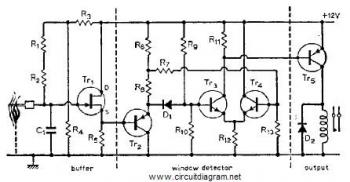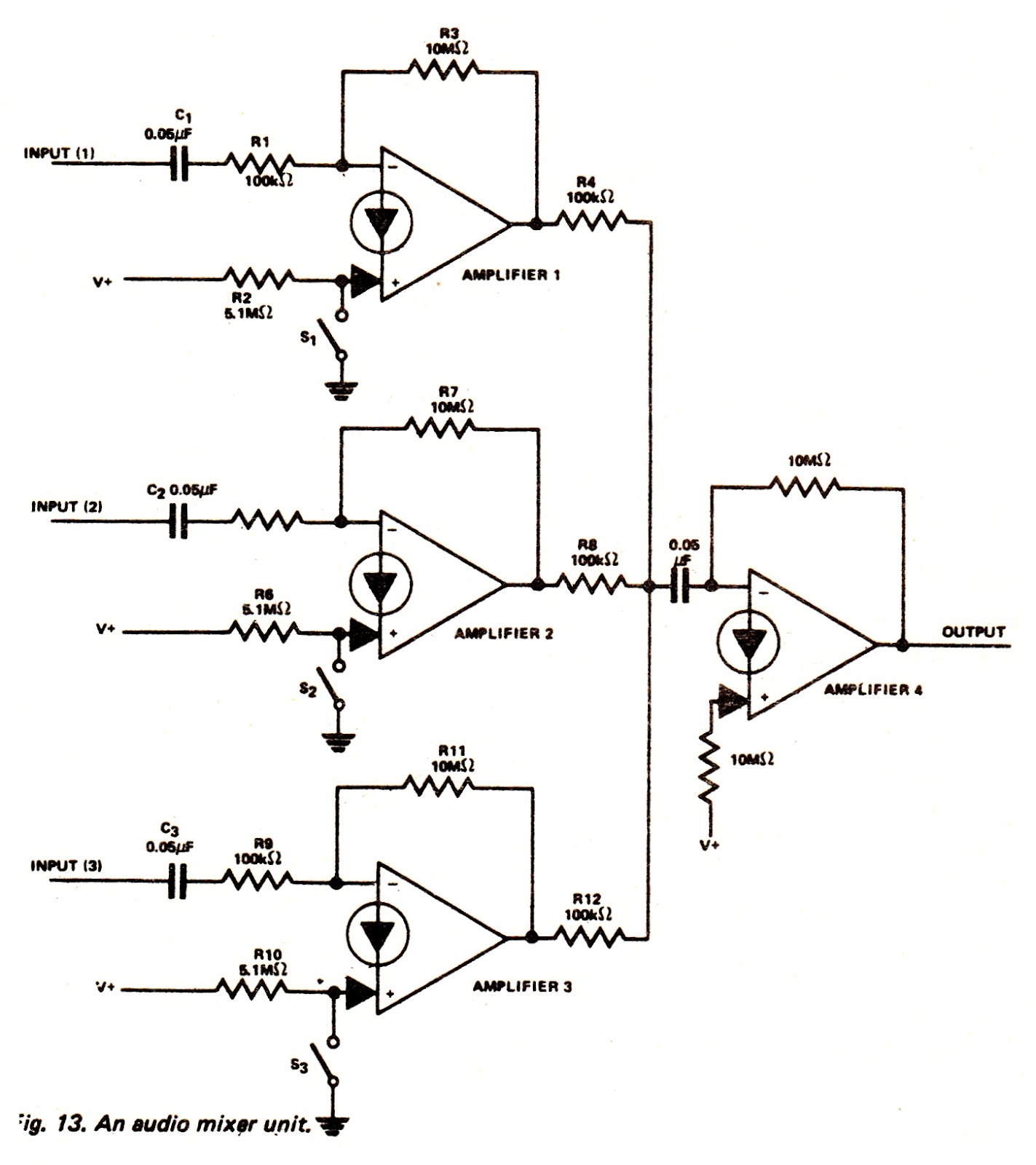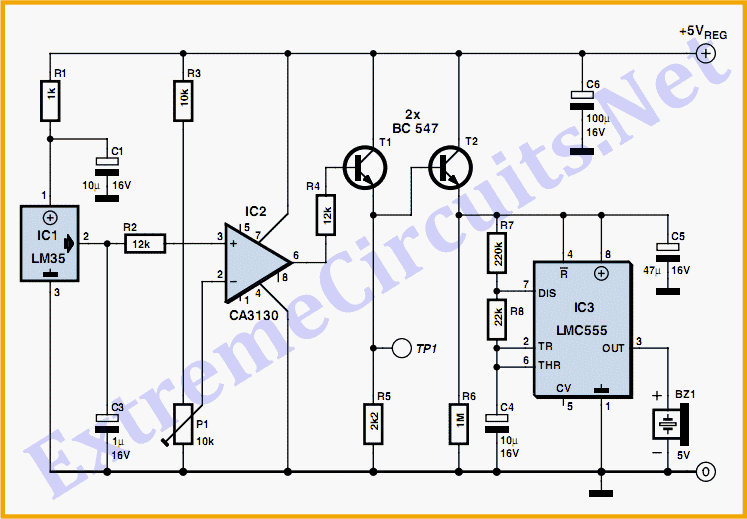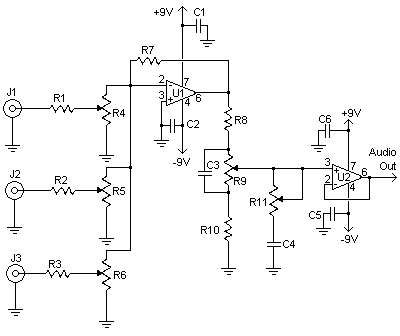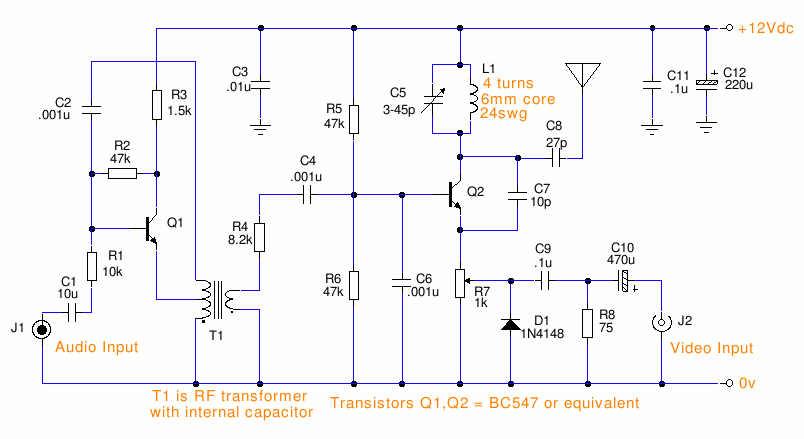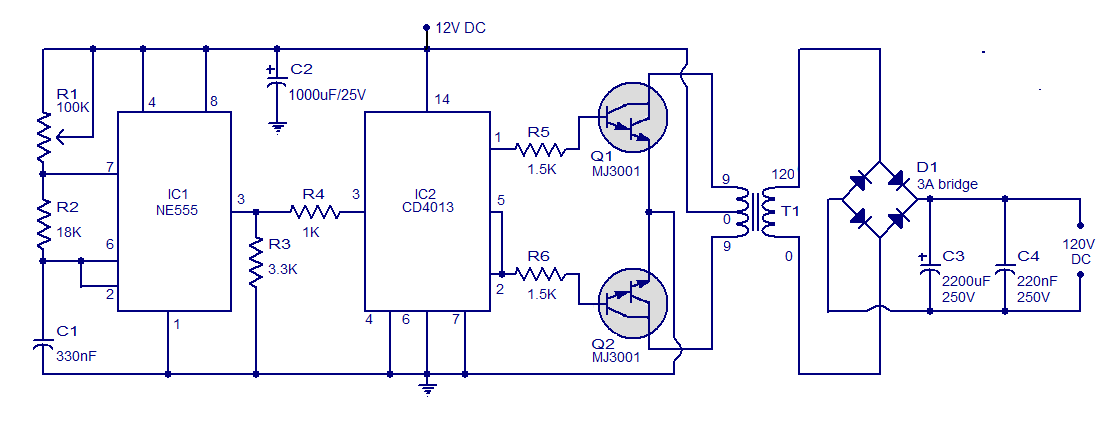
Simple humidity detector
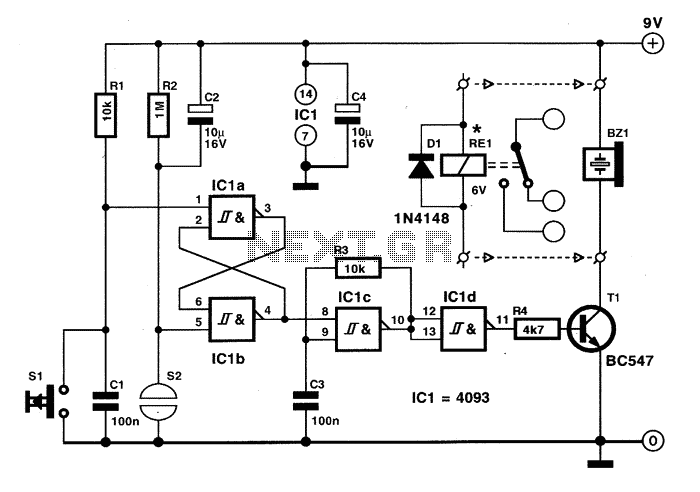
The primary function of this circuit is to activate a buzzer or a relay whenever the humidity level reaches a specified threshold. The main component is a memory element based on a flip-flop made up of gates and integrated circuits IC1a and IC1b. The output from this section triggers an oscillator (IC1c), which subsequently drives a piezoelectric speaker. Upon initial operation, the flip-flop is set to a logical '0' either through capacitor C1 or C2. Once activated, the reset is achieved through switch S1; however, this action is insufficient if the humidity sensor (designated as 82) remains wet.
The piezoelectric speaker may be substituted with an electromechanical relay, which can activate additional external devices such as a horn, lamp, or any other apparatus capable of providing a noticeable alert. It is important to note that since the current driving the relay coil is pulsed (DC = 50%), the voltage must be lower than the voltage of the humidity detector. For instance, if the supply voltage of the detector is 9 V, the relay should operate effectively at 6 V. The circuit typically consumes around 4-5 mA, but this can increase to 40 mA when the relay contacts are engaged. The supply voltage can range from 3 to 15 V; however, when operating at the lower end of the voltage range, the relay should not exceed 8 V. If the circuit proves to be overly sensitive during operation, the resistance value of R2 can be decreased.
This circuit utilizes a flip-flop configuration for memory retention, allowing it to maintain its output state until the humidity condition changes. The integrated circuits IC1a and IC1b serve as the core logic components, processing the input from the humidity sensor. The oscillator IC1c generates a signal that drives the piezoelectric speaker, providing auditory feedback when the humidity exceeds the set threshold.
The design allows for flexibility in the components used; for example, the piezoelectric speaker can be replaced with a relay that can control higher power devices. This adaptability is beneficial for various applications, from simple alert systems to more complex automation setups.
The current consumption characteristics highlight the efficiency of the circuit, enabling it to operate on a relatively low power supply while still providing sufficient current to control a relay. This feature makes it suitable for battery-operated devices or applications where energy conservation is critical.
In summary, this circuit effectively monitors humidity levels and activates a corresponding alert mechanism, with options for customization based on specific application requirements. Adjustments to component values, such as R2, allow for fine-tuning of sensitivity, ensuring optimal performance in diverse environmental conditions.The main (and only) job of this circuit is to activate a buzzer or a relay, each time the level of humidity takes a specific value. Main stage is a memory based on a flip-flop consisting of gates and IC1a IC1 b. The output of this step activates an oscillator (IC1c), which in turn leads to a piezoelectric speaker.
At the start of operation of the circuit, the flip-flop is driven to logical '0' or through the C1 or through C2. From the moment you excited, the reintroduction of the peace achieved through the switch S1, which however is insufficient if the sensor 82 continues to be wet.
The piezoelectric speaker can easily be replaced by a ilektronomo which in turn activates another external power device, such as a horn, a lamp or anything else is able to provide a distinctive indication. For the relay should note that because the current that drives the coil is pulsed (DC = 50%), the voltage should be less dp 'is the voltage of the detector.
If for example supply voltage of the latter is 9 n, then the relay is good to work at 6 V. The current circuit absorbs the rest of the order of 4-5 mA, but increased to 40 mA if the tow relay contacts. The supply voltage can be between 3 and 15 n, but if you use the lower limit relay is limited to 8 V.
If during the use of the circuit proved highly sensitive, you can reduce. the value of R2.
The piezoelectric speaker may be substituted with an electromechanical relay, which can activate additional external devices such as a horn, lamp, or any other apparatus capable of providing a noticeable alert. It is important to note that since the current driving the relay coil is pulsed (DC = 50%), the voltage must be lower than the voltage of the humidity detector. For instance, if the supply voltage of the detector is 9 V, the relay should operate effectively at 6 V. The circuit typically consumes around 4-5 mA, but this can increase to 40 mA when the relay contacts are engaged. The supply voltage can range from 3 to 15 V; however, when operating at the lower end of the voltage range, the relay should not exceed 8 V. If the circuit proves to be overly sensitive during operation, the resistance value of R2 can be decreased.
This circuit utilizes a flip-flop configuration for memory retention, allowing it to maintain its output state until the humidity condition changes. The integrated circuits IC1a and IC1b serve as the core logic components, processing the input from the humidity sensor. The oscillator IC1c generates a signal that drives the piezoelectric speaker, providing auditory feedback when the humidity exceeds the set threshold.
The design allows for flexibility in the components used; for example, the piezoelectric speaker can be replaced with a relay that can control higher power devices. This adaptability is beneficial for various applications, from simple alert systems to more complex automation setups.
The current consumption characteristics highlight the efficiency of the circuit, enabling it to operate on a relatively low power supply while still providing sufficient current to control a relay. This feature makes it suitable for battery-operated devices or applications where energy conservation is critical.
In summary, this circuit effectively monitors humidity levels and activates a corresponding alert mechanism, with options for customization based on specific application requirements. Adjustments to component values, such as R2, allow for fine-tuning of sensitivity, ensuring optimal performance in diverse environmental conditions.The main (and only) job of this circuit is to activate a buzzer or a relay, each time the level of humidity takes a specific value. Main stage is a memory based on a flip-flop consisting of gates and IC1a IC1 b. The output of this step activates an oscillator (IC1c), which in turn leads to a piezoelectric speaker.
At the start of operation of the circuit, the flip-flop is driven to logical '0' or through the C1 or through C2. From the moment you excited, the reintroduction of the peace achieved through the switch S1, which however is insufficient if the sensor 82 continues to be wet.
The piezoelectric speaker can easily be replaced by a ilektronomo which in turn activates another external power device, such as a horn, a lamp or anything else is able to provide a distinctive indication. For the relay should note that because the current that drives the coil is pulsed (DC = 50%), the voltage should be less dp 'is the voltage of the detector.
If for example supply voltage of the latter is 9 n, then the relay is good to work at 6 V. The current circuit absorbs the rest of the order of 4-5 mA, but increased to 40 mA if the tow relay contacts. The supply voltage can be between 3 and 15 n, but if you use the lower limit relay is limited to 8 V.
If during the use of the circuit proved highly sensitive, you can reduce. the value of R2.
